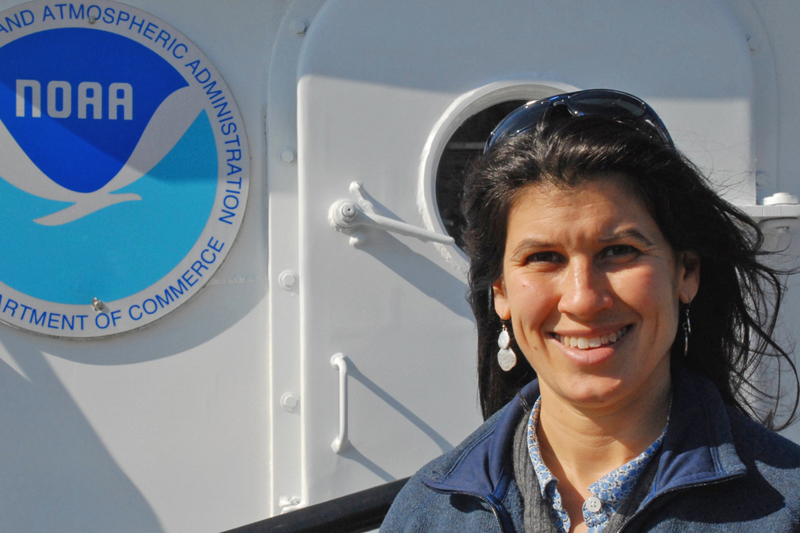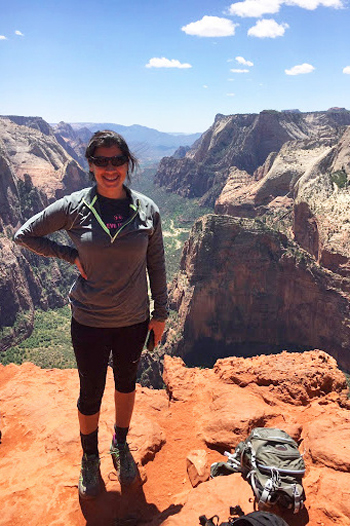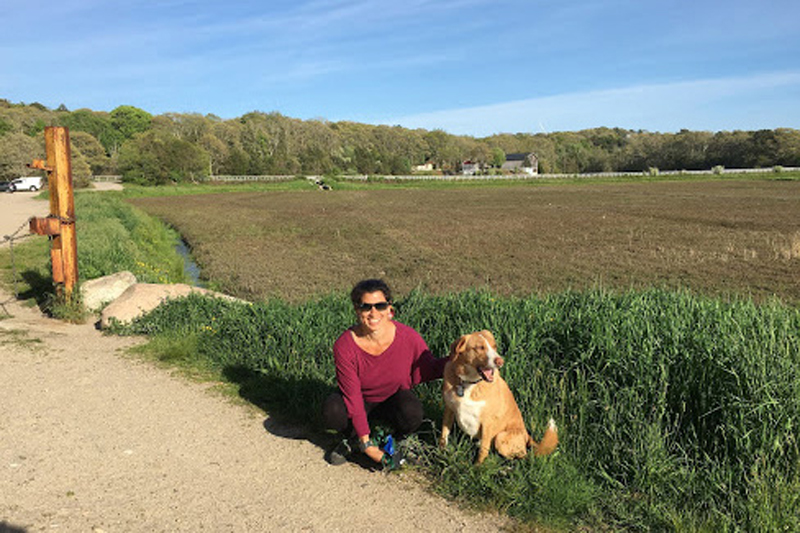
Kiersten Curti is research fishery biologist in the Population Dynamics Branch in the Resource Evaluation & Assessment Division and is located at our Woods Hole Laboratory in Woods Hole, Massachusetts.
Profile: Meet Kiersten Curti, Research Fishery Biologist and Conservationist
By NOAA / New England/Mid-Atlantic / August 25, 2020
Where did you grow up?
Pittsburgh! Pittsburgh may be land-locked, but it does have three rivers. And great professional sports teams.
Where did you go to school and what subject did you get your degree(s) in?
I completed my Bachelor of Science degree in biology from Allegheny College, a small liberal arts school in northwestern Pennsylvania. Two years later, I went to the University of Maryland’s Chesapeake Biological Lab for my master’s degree in marine, estuarine, and environmental science. My thesis looked at the distribution, abundance, and diet of the hogchoker, a small but ubiquitous flatfish in the Chesapeake Bay. I then continued on for my Ph.D. at the University of Rhode Island’s (URI) Graduate School of Oceanography. For my dissertation, I developed a multispecies population dynamics model that accounts for losses due to predation between species in the Georges Bank fish community.
How did you come to work at the Northeast Fisheries Science Center?
If you asked me as a sophomore at Allegheny where I saw myself in 10 years, I would have told you in sports medicine with a minor in Spanish. But like many undergraduates, I encountered a few key decisions regarding my path. I knew I wanted to participate in a study abroad program in a Spanish-speaking country my junior year. To ensure I was as prepared as possible, I took Spanish classes every semester for my first 2 years of college.
Unfortunately, near the end of my sophomore year I realized I had too many credits for a minor in Spanish. I didn’t have enough credits in upper-level science classes to graduate with a biology degree in 4 years and I didn’t want to stay a fifth year to complete my science requirements. My advisor recommended a program with Duke University where I could take upper level biology classes—particularly marine science classes—for a semester.
The program took me to Duke University’s Nicholas School of the Environment in Beaufort, North Carolina, for 2 months. I went to the Bermuda Biological Station for Research for two additional months. At the end of this semester, I decided to specialize in aquatic biology.
After graduating from Allegheny, I taught environmental education on a salt marsh in Delaware for the Delaware Aquatic Resource Education Center. I worked for an environmental consulting company in Miami, Florida, before going to the Chesapeake Biological Lab for my master’s degree.

Kiersten enjoys Crossfit, running, and hiking. Here she takes a moment to enjoy the view from Observation Point along the Observation Point trail in Zion National Park. Photo courtesy of Kiersten Curti.
While at URI, I successfully competed for a NOAA Fisheries-Sea Grant fellowship in population dynamics. This fellowship program seeks to strengthen relationships between academic and NOAA Fisheries’ scientists and encourages students to pursue careers in population and ecosystem dynamics. Through my dissertation work, I was fortunate to have the opportunity to collaborate with members of the Science Center’s Population Dynamics, Population Biology, Ecosystem Dynamics and Assessment, and Oceans and Climate Branches. Jason Link was my NOAA Fisheries mentor, and Chris Legault, Jon Hare, and Larry Buckley (retired) were also on my dissertation committee.
Toward the end of my dissertation, three jobs posted in the Population Dynamics Branch at the Science Center’s Woods Hole Lab. I figured it couldn’t hurt to throw my hat in the ring. I was quite fortunate to have been offered one of these positions and have been a part of the Population Dynamics Branch since 2011.
What do you do at the Science Center?
The Population Dynamics Branch is responsible for stock assessments of approximately 40 different fish and invertebrate species managed in the Northeast United States. To complete these assessments, we develop population models that incorporate data from the fishery—including from dealers, vessel trip reports, fishery observers, and cooperative research studies. We also use data from independent monitoring surveys like our bottom-trawl and ecosystem monitoring surveys. These population models estimate the underlying status of the stock, that is, whether the stock is overfished or not, and whether overfishing is occurring.
I am the lead assessment scientist for Atlantic mackerel, and in the next year, will become the lead for black sea bass as well. I am also the NOAA representative on the stock assessment committees for river herring, American shad, and Atlantic sturgeon. The assessments for these state-managed fisheries are led by the Atlantic States Marine Fisheries Commission. Their assessment committees can have representatives from each coastal state as well as NOAA and the U.S. Fish and Wildlife Service.
I initially became involved in river herring and shad because a management action was being developed to minimize their bycatch in the Atlantic mackerel fishery. When NOAA received a petition to list river herring under the Endangered Species Act (ESA), I was asked to be part of a status review team. We reviewed the best available scientific information on the biology, ecology, abundance, population trends, and threats to the species to evaluate their extinction risk. Our Greater Atlantic Regional Fisheries Office used this information to determine if river herring should be listed under the ESA.
For the last several years, I have been a U.S. representative on the Advice Committee of the International Council for the Exploration of the Sea (ICES), an intergovernmental marine science organization. The committee has one representative from each ICES member country and provides advisory services for more than 200 fish stocks.
What do you like most about your position?

Kiersten and her rescue dog, Oliver, on their daily adventures along a local cranberry bog. Photo courtesy of Kiersten Curti.
I have always enjoyed the STEM fields, but what drew me to fisheries science was its applied nature and relevance. It is not just science that is driven by curiosity, but science that is driven by an explicit need and has a direct impact. Fisheries are important as a sustainable food source and as an economic sector supporting coastal communities and people’s livelihoods. I find population dynamics to be a continual challenge and a field where there is never a shortage of opportunities for learning and professional growth. Sometimes it can be overwhelming—there is always so much that you don’t know—but it also keeps it interesting. Within the trenches of population dynamics, I especially enjoy coding and learning new programming languages. I enjoy applying them to current questions, problems, and projects that we have in our branch.
What are some of your hobbies?
I have a 5-year-old rescue dog from West Virginia. His name is Oliver and he consumes a lot of my time, but in the best of ways. When he was a puppy, my daily goal was to tire him out. Now that he is an adult, well, I guess my goal hasn’t changed much. He is a little high maintenance and a fragile soul as a result of whatever happened to him in his first few months, but he is adorable, and therefore, manages to get away with it. Since the pandemic began, he has been a great excuse for long daily walks on the cranberry bogs, in the woods and around Lawrence Island.
In addition to dog walks, I enjoy Crossfit, running, and hiking. I have taken several hiking trips with my father and sister over the years that took us to Mt. Rainier, Zion, Bryce Canyon, Grand Canyon and Glacier National Parks. Outside of exercise, I enjoy cooking, and especially eating, gardening, kayaking, and lazy days on a warm beach.
For more information, please contact Heather Soulen.






